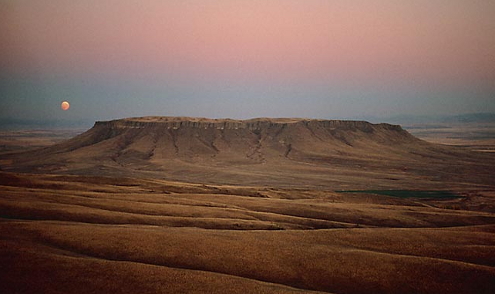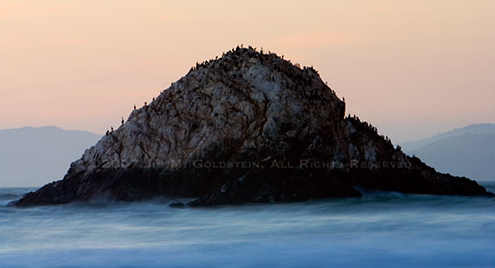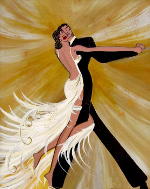|
|
Rise, Fall, and the
Foxtrot Three Step
by Harold & Meredith Sears
 Foxtrot is one of the Smooth
Rhythms,
along with waltz, quickstep, and tango, but it is a particularly
smooth rhythm, with its long steps, easy flow, and its gliding motion
around the floor. One of the features of foxtrot that gives it this
smooth look is early rise. We take our first step heel to toe, we
straighten the leg, we even stretch a little in the torso (being
careful not to lift our shoulders toward our ears). We have "foot
rise" and "body rise" -- we are up at the end of the
first step. We take the second step on the ball of the foot, staying
up. The third step is on the ball, and we lower through the body and
to the flat of the foot only at the end of step 3. We get up quickly,
we soar like a bird, and we lower at the end, ready to do it again.
The shape of foxtrot rise and fall is like a flat western mesa. Foxtrot is one of the Smooth
Rhythms,
along with waltz, quickstep, and tango, but it is a particularly
smooth rhythm, with its long steps, easy flow, and its gliding motion
around the floor. One of the features of foxtrot that gives it this
smooth look is early rise. We take our first step heel to toe, we
straighten the leg, we even stretch a little in the torso (being
careful not to lift our shoulders toward our ears). We have "foot
rise" and "body rise" -- we are up at the end of the
first step. We take the second step on the ball of the foot, staying
up. The third step is on the ball, and we lower through the body and
to the flat of the foot only at the end of step 3. We get up quickly,
we soar like a bird, and we lower at the end, ready to do it again.
The shape of foxtrot rise and fall is like a flat western mesa.
In contrast, waltz is less flat
and
more undulating. We begin to rise at the end of the first
step, we continue to rise during step 2 and even into step 3,
and then we lower at the end of step 3. Our rise is more gradual,
more wave-like, with crests and troughs, a gentle up-and-down
breathing. The shape of waltz rise and fall is more like a softly
eroded ocean island.
 So, waltz is something of a roller
coaster, and foxtrot is more of a high traverse on skis. But the
foxtrot Three Step is a little different. It consists of three
forward steps (SQQ). In banjo or in closed position, the first step
is forward L (lady bk R). The man steps heel to toe, as you would
expect, and he can begin a little body rise, but the second step is
forward R, also heel to toe (lady bk L). The figure begins with two
heel leads. So, our foot rise and full rise is delayed until the end
of the second step, and as usual, we lower at the end of step 3 --
forward L to closed position. The full rise in this figure lasts only
about one beat. So, waltz is something of a roller
coaster, and foxtrot is more of a high traverse on skis. But the
foxtrot Three Step is a little different. It consists of three
forward steps (SQQ). In banjo or in closed position, the first step
is forward L (lady bk R). The man steps heel to toe, as you would
expect, and he can begin a little body rise, but the second step is
forward R, also heel to toe (lady bk L). The figure begins with two
heel leads. So, our foot rise and full rise is delayed until the end
of the second step, and as usual, we lower at the end of step 3 --
forward L to closed position. The full rise in this figure lasts only
about one beat.
Maybe this sounds like a really
small
and technical detail -- does it really matter whether we dance the
second step with a heel lead or not? -- but if you don't, you can
come over and overpower your lady. In a good closed position, with no
side lead, no feathering, no contra-body shaping, if you dance
heel/toe, to the toe of the second step, if you are up and driving
forward, then she is pushed away, perhaps a bit to his right, and you
end up out of position. If you stay down, you will move into her
rather than over her, and you will stay beautifully together for that
delayed rise.
Let's compare the Three Step to
the
Feather. To Feather from closed position, we step forward R (lady bk
L), turning the body a little right-face (left side lead). The man
steps heel to toe and rises to foxtrot soaring height. The second
step is forward L on the ball of the foot. We can use this
early rise, as we do in most other foxtrot figures (e.g., Telemarks,
Weaves, Turns, Hovers), because we are not moving into our
partner with the right foot. We are sliced, in banjo, with
contra-body position. This shaping softens the power of the step. The
third step is forward R across the left leg ending in banjo, toe to
heel and lowering for the next figure.
A nice practice exercise is dancing the Three Step to closed
position; Feather to banjo; Three Step to closed ; again, and again.
The most important skill to work on in this exercise is the blending
from closed position in the Three Step, with shoulders perpendicular
to line; to a tight, contra-body banjo position in the Feather, with
left-side lead and shoulders diagonal to line; back to closed
position, and so on. But, at the same time, try alternately to use
early rise in the Feather, late rise in the Three Step, and see if
you don't feel more comfortable. This skill is not only useful to the
man. Let the lady try the same late rise in the Back Three step and
in the second measure of the Reverse Wave. Here, she is dancing
forward L and then forward R in closed position, and two heel leads
should feel smoother and less bumpy. Pick a dance at a level below
where you usually learn -- phase IV or even phase III (where the cue
in closed position might be "Forward Run Two"). Again, try
two heel leads and late rise on the right foot. Does it feel better,
more in control?
A brief version was
published in the Washington Area Square Dancers
Cooperative Association (WASCA) Calls 'n'
Cues, September 2011. An expanded version was published in the
DRDC Newsletter, July/August
2012; and reprinted in the LRDTA
Footnotes In the Round, May/June 2013; and CRDA Round Notes, June/July 2013
.

If you would like to read other articles on dance
position, technique, styling, and specific dance rhythms, you may visit
the article TOC.
Past DRDC Educational Articles archived here.
Go beyond this site. Find other references on our Sources and Links
pages.
|

